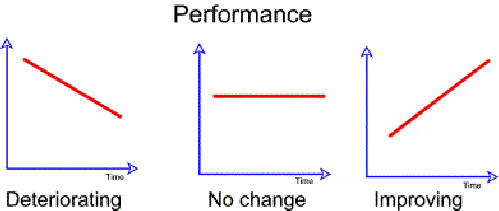Improvement is beneficial change
Business improvement is a beneficial change in business performance
Continual improvement is a recurring activity to increase the ability to fulfil requirements.
The anatomy of change
There are three things that are certain in this life, death, taxes and change! . Change is improvement if it is beneficial and a retrograde step if it is undesirable but there is a middle ground where change is neither desirable nor undesirable – it is inevitable and there is nothing we could or should do about it. Change is a constant. Its effects can be desirable, tolerable or undesirable.
- Desirable change is change that brings positive benefits to the organization.
- Tolerable change is change that is inevitable and yields no benefit or may have undesirable effects when improperly controlled.
The challenge is to cause desirable change and to eliminate, reduce or control undesirable change so that it becomes tolerable change. We cannot improve anything unless we know its present condition and this requires measurement and analysis to tell us whether improvement is both desirable and feasible.
Improvement is always relative. In terms of business performance, there are only three states. Businesses are either in decline, remaining stable or improving. To cause performance to be in one of these states requires action. Performance deteriorates because of inappropriate action or inaction. Bringing performance back to where it should have been is not improvement, neither is fire fighting or resolving random problems. However maintaining the status quo requires improvement. To maintain market position, keep customers, retain capability requires a lot of effort so improvement is not only about pushing forward the frontiers. In an environment in which all around you is changing you need to continually measure your performance against that of your competitors and identify any threats to continued success
Types of improvement
Improvement can be targeted at specific characteristics, specific activities, specific products, specific processes or specific organizations. When targeted at a specific characteristic it may involve reducing variation in the measured characteristic. When targeted at specific products it may involve major modification – product upgrade. When targeted at the organization it may involve major re-organization or re-engineering of business processes. To appreciate the scope of meaning you need to perceive requirements as a hierarchy of needs. At the lowest level are the needs of the task, passing through to the needs of the process, the needs of the system and ultimately the needs of the organization. At each level improvement is about improving efficiency and improving effectiveness.
Improvement process
There is a universal improvement process that can be applied to any type of improvement.
- Determine the objective to be achieved, e.g. new markets, products or technologies, or new levels of organizational efficiency or managerial effectiveness, new national standards or government legislation. These provide the reasons for needing change.
- Determine the policies needed for improvement, i.e. the broad guidelines to enable management to cause or stimulate the improvement.
- Conduct a feasibility study. Discover whether accomplishment of the objective is feasible and propose several strategies or conceptual solutions for consideration.
- Produce plans for the improvement that define the processes by which the objective will be achieved.
- Organize the resources to implement the plan.
- Carry out research, analysis and design to define a possible solution and credible alternatives.
- Model and develop the best solution and carry out tests to prove it fulfils the objective.
- Identify and overcome any resistance to the changes proposed
- Implement the change, i.e. put new products into production, new processes into operation and new services into operation.
- Put in place the controls to hold the new level of performance.
